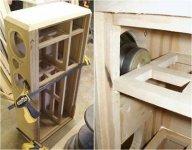SkinnyBoy said:
I actually think (hehe) I found when routering, and sawing 25mm MDF, that some parts seemed to be harder and softer than others.... perhaps it was just my imagination, but sometime the saw would struggle, and other times it would cut like a knife...
So many factor involved... MDF still made out of wood you know! If the wood is stronger or weaker then you get stronger/weaker MDF, no ?
 The only thing different with MDF is that you get an overall rigidity. So if you cut where the grain is more dense or more rigid you need more energy to...blablabla, right?
The only thing different with MDF is that you get an overall rigidity. So if you cut where the grain is more dense or more rigid you need more energy to...blablabla, right?MDF has no 'grain', it's a very uniform mix of wax, glue, and sawdust heated and compressed under high pressure into sheets: http://www.merbok.com/mdfoverview/process.htm
The ratio of the materials determines its rigidity, not the type of sawdust used.
GM
The ratio of the materials determines its rigidity, not the type of sawdust used.
GM
Would certain hardwoods like ash be suitable for smaller speakers? From what I gather MDF is a kind of compromise between stiffness , ease of use and cost and is not always necessarily the best material for speakers that I originally thought.
>Would certain hardwoods like ash be suitable for smaller speakers? From what I gather MDF is a kind of compromise between stiffness , ease of use and cost and is not always necessarily the best material for speakers that I originally thought.
====
Unless you want a massive cab, MDF is best only when the desired BW is above its Fs, which on average is around 400Hz..........
Yes, any of the hardwoods with low moisture retention properties is suitable, such as white oak, white ash, black ash, green ash, and hard maple. Then for those with machining capability or more patience than me: Lignum Vitae, Kingwood, Cocobolo, Tulipwood, Pau Ferro, Honduras Rosewood, Goncalo Alves, Bubinga, Wenge, and Purpleheart.
There may be others, but this is all I could quickly find.
GM
====
Unless you want a massive cab, MDF is best only when the desired BW is above its Fs, which on average is around 400Hz..........
Yes, any of the hardwoods with low moisture retention properties is suitable, such as white oak, white ash, black ash, green ash, and hard maple. Then for those with machining capability or more patience than me: Lignum Vitae, Kingwood, Cocobolo, Tulipwood, Pau Ferro, Honduras Rosewood, Goncalo Alves, Bubinga, Wenge, and Purpleheart.
There may be others, but this is all I could quickly find.
GM
Code:
Material MOE(PSI) Density (g/cm3) Laminations per cm
MDF 530,000 48 lbm/cubic foot NA
Baltic Birch 1,800,000 ? 7-9
Hydulignum (1) 2,030,457 84.3 lbm/cubic foot 8
Hydulignum (2) 2,393,038 84.3 lbm/cubic foot 20Anyone know the desnity of BB? Any contenders to compete with Hydulignum?
Unfortunately, the cost of Hdyu makes me dizzy, but the cheap grade is not out of reach (~£125 for 2m x 1m x 16mm sheet).
Around 41lbs/ft^3. The Hydulignum looks interesting, but like Corian, etc., isn't worth the $$ difference compared to 19mm/13ply BB ply IMO. Then there's the added wear n' tear on your tools........
GM
GM
Well, reverting back the original topic, here's a pic of the bracing strategy I ended up using. 😀
All sub-panels are different in size. The vertical brace was placed using the infamous 1:1.6 ratio. Also jammed the horizontal braces against the woofers (and used T-nuts).
Thanks for all the input.
All sub-panels are different in size. The vertical brace was placed using the infamous 1:1.6 ratio. Also jammed the horizontal braces against the woofers (and used T-nuts).
Thanks for all the input.
Attachments
Hi!
I have 15cm mid-bass unit and I have made 20L bass reflex box from 16mm MDF(about 20x20x70cm).Is cross-bracing needed(in my option)?Im beginner, so I have never heard the difference between braced and not braced box(same sistem).
I have 15cm mid-bass unit and I have made 20L bass reflex box from 16mm MDF(about 20x20x70cm).Is cross-bracing needed(in my option)?Im beginner, so I have never heard the difference between braced and not braced box(same sistem).
A little bracing will never hurt. 70 x 20 isn't realy small, so I would put some bracing in the box if I were you.
Well, not realy squeeze. A speaker makes the panels vibrate. Since the Sd of such a panel is bigger then the Sd of the speaker the amplitude of the vibration doesn't need to be very big to produce enough sound to influence the timbre of the speaker. In most cases coloration by resonances of the box do not sound realy nice.
That's why you need to brace the box. This way the panels don't vibrate as much and you will have less coloration of the sound.
That's why you need to brace the box. This way the panels don't vibrate as much and you will have less coloration of the sound.
- Status
- Not open for further replies.
- Home
- Loudspeakers
- Multi-Way
- Enough bracing?

